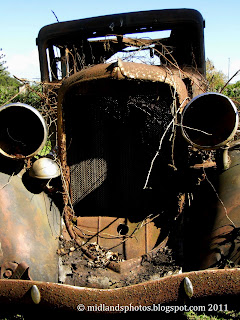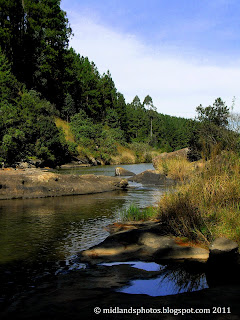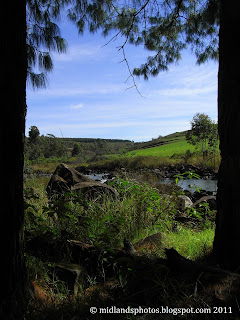 I do try to cover a new or different aspect of life in the Midlands every day. But - there are a couple of images from last weekend’s Cars In The Park in 'Maritzburg that are too good to waste and so I’m about to change the rules (which I make up myself as I go along anyway :-) and do two consecutive posts covering CITP 2011.
I do try to cover a new or different aspect of life in the Midlands every day. But - there are a couple of images from last weekend’s Cars In The Park in 'Maritzburg that are too good to waste and so I’m about to change the rules (which I make up myself as I go along anyway :-) and do two consecutive posts covering CITP 2011.One exhibit which caught most visitors’ imagination was this delightful old Plymouth (1938 P5??) wreck. The theme of the event was “restoration in progress” - and this old girl sure has some way to go! I don’t know if the owner has any intention of her ever becoming anything more than the curiosity she already is, but by the end of the day at least one dedicated preservationist had left a note on (what was once) her dashboard seeking to make contact*. Best of luck to you both!
The old adage about small things … came to mind while seeking the perfect angle to shoot Miss Plymouth. Amazingly she had been transported to the show with her mantle of overgrown brambles and cobwebs intact. Even more amazingly the spinner of the web was still in residence, and many a sceptical onlooker had trouble, and collectively they spent hours, trying to decide if the spider was alive or a planted plastic job. Trust me – it was the real Incy-Wincy*.
* (see image 2 -click to enlarge)
I guess in allocating locations to exhibits, not a lot of thought goes into how easily photographers will be able to capture good images of displays. One of the most elementary things any future sharpshooter learns is to beware of capturing background objects appearing to ‘grow out’ of a main subject. With a bowling club hard at play behind her, and a modern truck parked left of the exhibit, framing the car was made extra difficult by a lamp post just to her right. All solved by just the right low angle and a bit of judicious cropping.
And now, as a bonus I have to sneak in a shot of the legendary E-Type Jaguar. Probably the first car to feature in my youthful recurring motoring dreams, incredibly it was fifty years ago this year that the world first saw the E-type, at the April 1961 Geneva Motor Show. I’m still dreaming!
 A little further downstream from yesterday’s post and the view across the Karkloof Stream down towards the falls gorge becomes less pastoral and somewhat more dramatic. With lichen covered rocks casually strewn by nature forming small pools and islands and the natural wild African grasses contrasting with the man-made forests of pine and gum the colour palette is subtle and appealing. On one of the small rocky islands were the ashen remains of a small impromptu braai-pit, and I can only imagine how atmospheric the event must have been on a clear summer evening – Midlands life at its most relaxing.
A little further downstream from yesterday’s post and the view across the Karkloof Stream down towards the falls gorge becomes less pastoral and somewhat more dramatic. With lichen covered rocks casually strewn by nature forming small pools and islands and the natural wild African grasses contrasting with the man-made forests of pine and gum the colour palette is subtle and appealing. On one of the small rocky islands were the ashen remains of a small impromptu braai-pit, and I can only imagine how atmospheric the event must have been on a clear summer evening – Midlands life at its most relaxing. 

